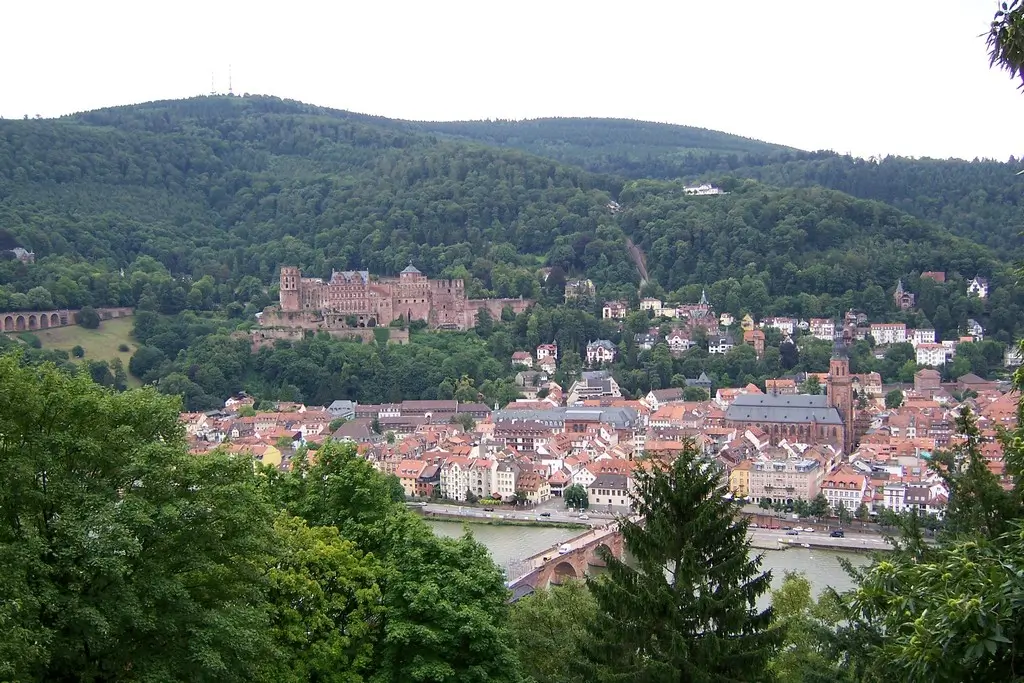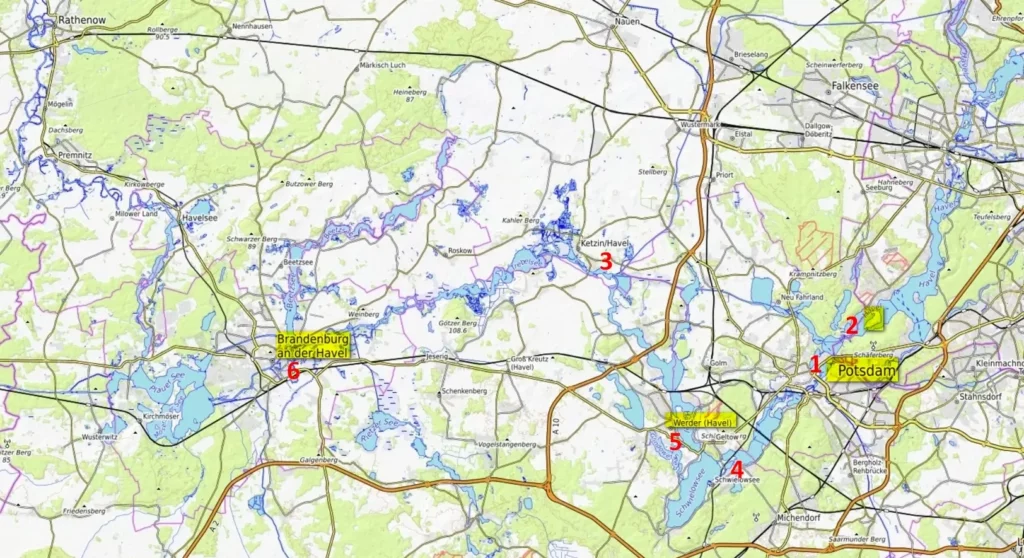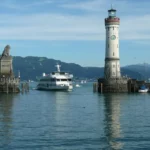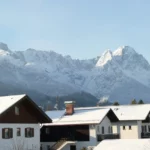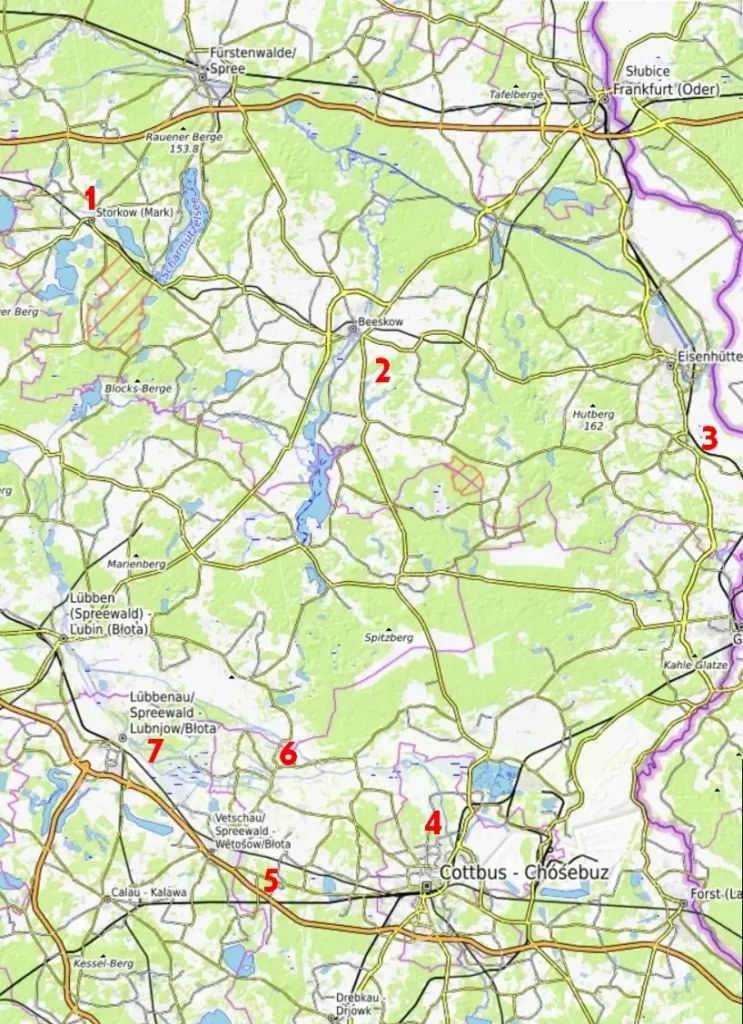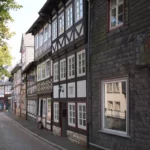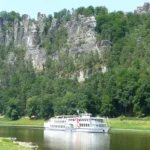Last Updated on 31/01/2023
Heidelberg is an old student town, one of the most beautiful cities in Germany.
A half-ruined ghost castle on a mountain, the blue water of the Neckar, an ancient bridge, university buildings – all this gives the city a special charm.
Castle Road (Burgenstrasse). 1. Neckar cycle route Mannheim – Eberbach
Castle Road. 2. Neckar valley cycle route. From Zwingenberg to Bad Wimpfen
Technik museum Speyer
Castle Road. 3. From Sinsheim to Rothenburg ob der Tauber
Stuttgart What to see
Schwäbisch Hall. 1. What to see in old town
History in dates
600 thousand years – the approximate age of the “Heidelberg man”, whose bones (lower jaw) were found at the beginning of the 20th century.
5th c. BC. – Celts build a fortification on Heiligenberg.
Around 80 AD, the Romans set up a permanent camp and built a signal tower on the banks of the Neckar and a wooden bridge over the river.
260 AD the Romans were expelled by the Germans.
5th c. – development of permanent settlements.
863 – on the hill Heiligenberg (Holy Mountain) the monastery of St. Michael was founded. The monastery was built on the ruins of the Celtic fortifications of the 5th century BC.
1155 – the first castle was built, the settlement from under the authority of the bishops of Worms passes into the possession of the Hohenstaufen dynasty (Count Palatine Konrad)
1196 – Heidelberg was first mentioned in the annals and became the residence of the palatine counts.
1386 – Count Palatinate Ruprecht I, one of the seven elector of the Reich, founds the University of Heidelberg.
1620 – Count Palatine Friedrich 5, the leader of the Protestants, receives the Bohemian crown, but rules only one winter, for which he is nicknamed the “winter” king. The battle he lost near Prague gives rise to the 30-year war.
1649 – Friedrich’s son Karl Ludwig gets the opportunity to return to the royal residence. To increase his influence, he marries his daughter to the Duke of Orleans.
1685 After the death of the childless son of Karl, King Louis XIV claims the inheritance. The claims are rejected and the War of the Palatinate Succession begins. In 1689 the city was captured by French troops and in 1693 it was almost completely destroyed.
1720 – as a result of a religious conflict with the inhabitants, Count Carl Philipp moves the residence to Mannheim.
In the 18th century the city is restored in the Baroque style.
1803 – Grand Duke Karl Friedrich of Baden reopens the university, which is now called Ruperto-Carola after the first and second founders.
During World War II, Heidelberg escaped bombardment. The university reopened in 1945.
What to see in Heidelberg
Heidelberg Castle (Schloss Heidelberg)
Dominates the city, of course, the castle. This giant, which has existed for so many centuries, hangs over the old city during the day, and at night it becomes especially mysterious and impressive thanks to the backlight.

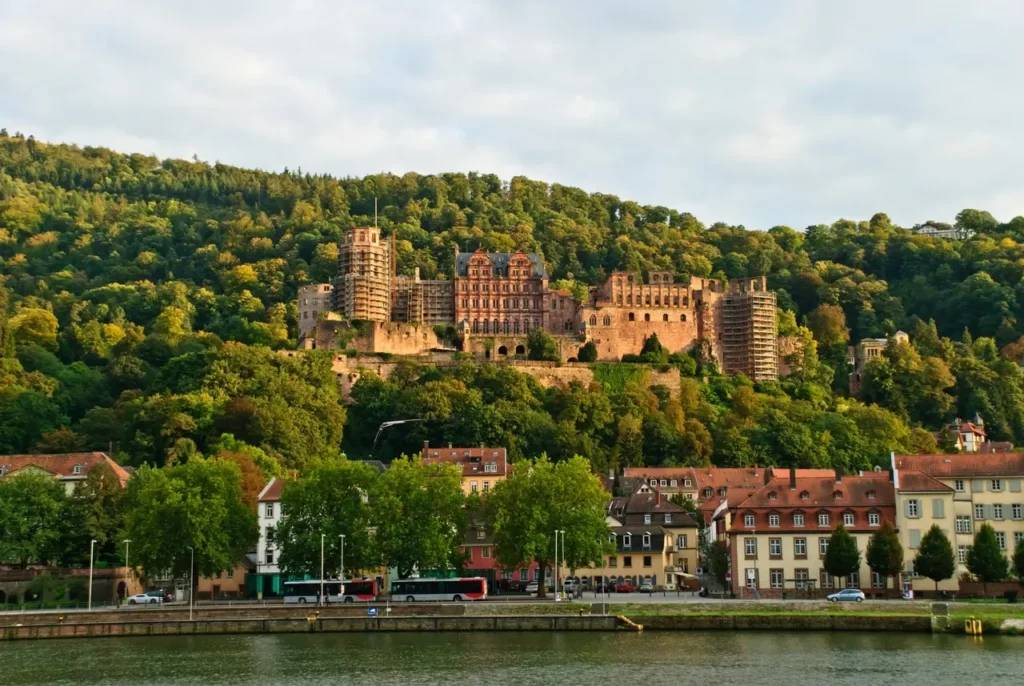
From the end of the 14th century, the reign of the first German king Ruprecht 3, until 1764, the castle, with the exception of periods when no one lived in it, was a residence.
It was rebuilt several times, and now you can see the remains of a medieval castle, and Gothic, and Renaissance architecture. One of the finest Renaissance palaces north of the Alps was built under Otto Heinrich (mid-16th century).
In 1622, during the 30 Years’ War, the castle was conquered, and the unique Palatine Library (Palatine – “palace” in Latin) was moved to the Vatican. After the war with the French over the inheritance of the Palatinate and the fire, the castle turned into ruins. Thanks to the care of the French emigrant Charles Gremberg, who preserved the ruins since 1810, the castle has been preserved at least in this form and is gradually being restored.
Almost nothing has been preserved from the interiors of the castle. With an additional ticket, you can get on an excursion (with an audio guide in different languages) to the preserved small part of the castle.




With a regular ticket, which simply allows you to enter the territory, you can see the largest barrel in the world and the pharmaceutical museum.
The largest barrel is really impressive in its size. It was built in 1751 to collect wine – such a tax was paid by winegrowers in the Palatinate. Its dimensions are: 7 m high, 8.5 m wide. It holds 220 thousand liters of wine. But for practical use, it turned out to be not very convenient.
The German Pharmaceutical Museum (Deutsches Apotheken-Museum) is a unique pharmaceutical museum. It has a rather curious collection: various devices, from the most ancient to quite modern, used for the manufacture of medicines, storage devices, an apothecary laboratory, a collection of medicinal plants and ancient medicines.
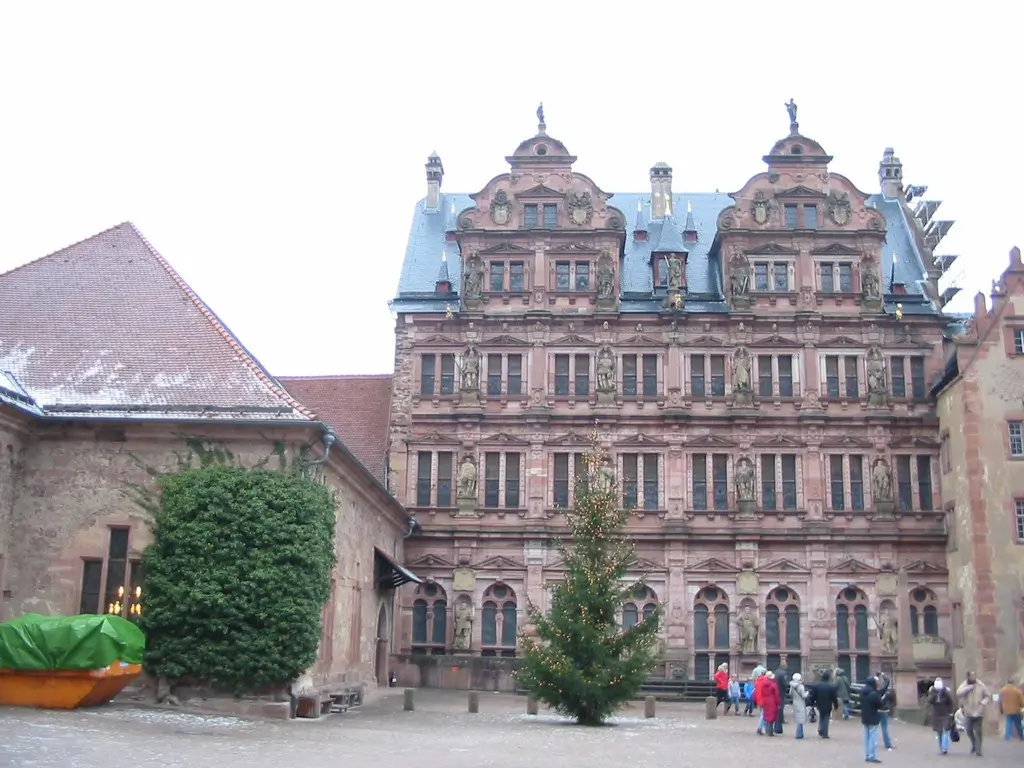


City view from the castle

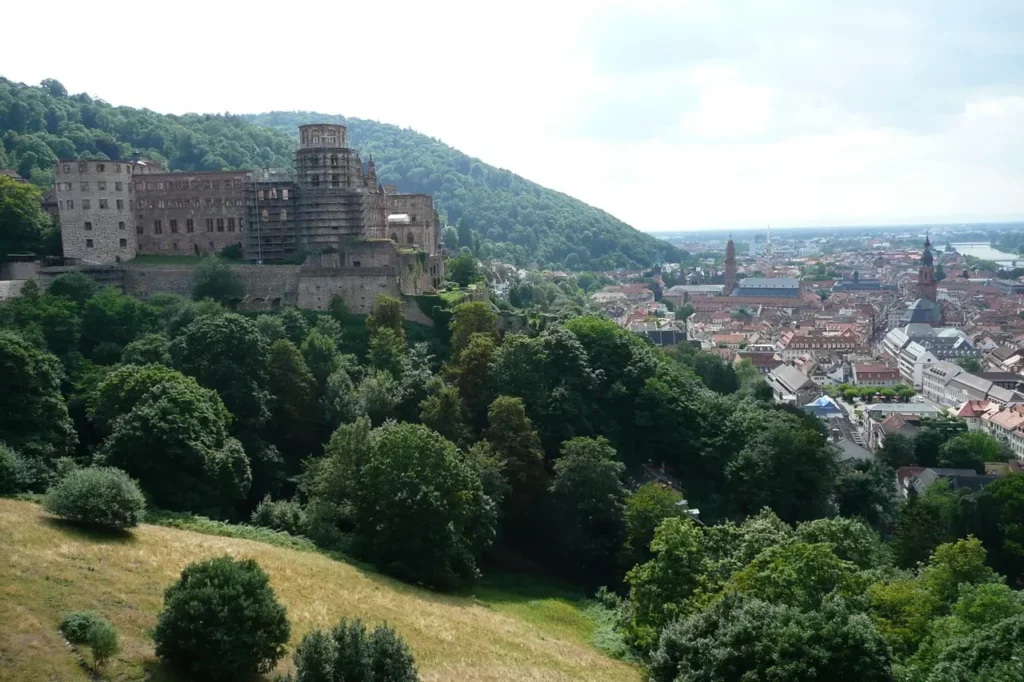
The castle park was laid out at the beginning of the 17th century and destroyed at the end of the 17th century during the war with the French. During its short existence, the park was widely known. There were many flowers, fountains, an artificial grotto.
Three times a year, fireworks are arranged in the castle as a sign of severe destruction and fires in the castle. They shoot from the castle and from the Old Bridge, so it is best to watch from the bridge over the dam and from the opposite bank.
Funicular and Königstuhl
Heidelberg is home to the oldest funicular in Germany. In its lower part, it was opened in 1890. The lower part was completely renovated. The upper part was opened in 1907 and, after renovation, retained its original features. Therefore, it was included in the list of historical heritage.
There are three stops on the road: Schloss, Molkenkur (with a restaurant and a hotel), Königstuhl (a simple park for children, falcons, a restaurant, a hotel, an observatory, a television tower).
There is no full view of the city from the top.
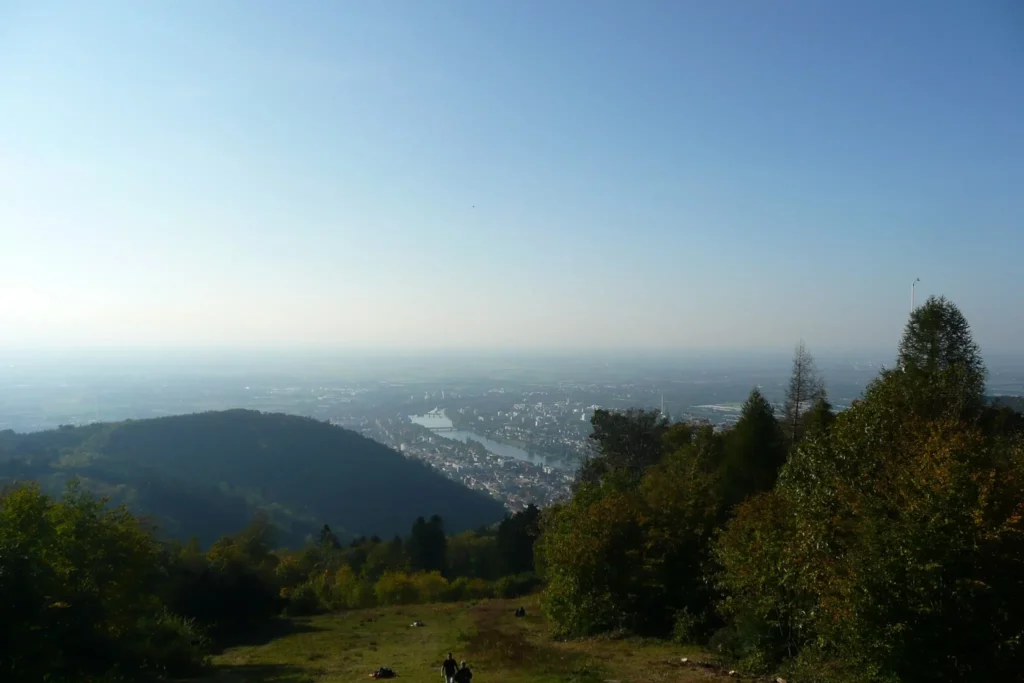
Königstuhl from below.

You can also climb the mountain by bus. It’s significantly cheaper than the funicular, or free if you have day passes.
The descent down on foot is poorly marked, quite long and not very interesting. For short walks, the hill opposite, Heiligenberg, is more suitable.
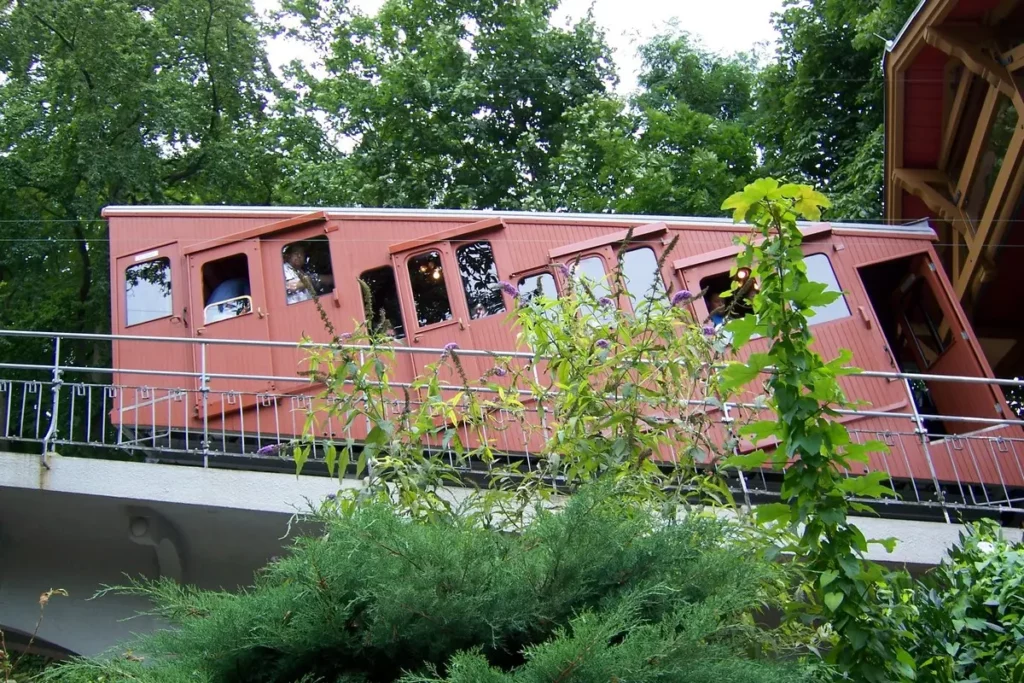
Market Square (Marktplatz)
Since the Middle Ages, the Market Square has been the center of city life; not only markets were held here, but also executions, the burning of witches and heretics. Now markets are held on the Market Square twice a week.
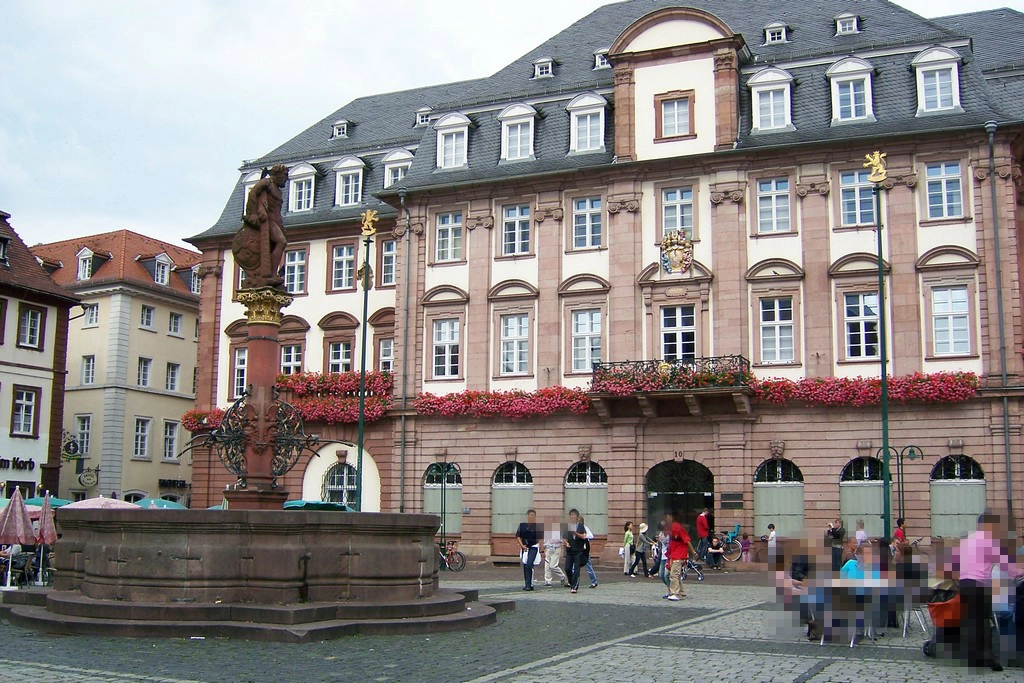
In the center of the square is a fountain from the early 18th century depicting Hercules. The town hall, which is located on the square, was built simultaneously with the fountain on the site of the old one, destroyed during the war with the French, and then rebuilt and expanded several times.
Opposite the Town Hall is the Church of St. Spirit, next to it – the hotel “At the Knight of St. George.”

Church of St. Spirit (Heiligeistkirche, on the left) was first mentioned in documents in 1239. In 1398, the first stone of the present church was laid. Kings were buried in the church, but their graves were destroyed in 1693. Until 1623, the largest collection of handwritten books and documents in Europe, the Palatine Library, was kept in the church. It came to the Vatican during the 30 Years’ War.
Hotel “At the Knight of St. George” (Zum Ritter st. Georg) – a carved building opposite the Church of the Holy Spirit, representing the typical urban architecture of Heidelberg before its destruction. The building was built in 1592 by a Huguenot merchant and named after the statue of a knight at entrance. Almost the entire time of its existence since the end of the 30-year war, it has served as a hotel and restaurant.

Agricultural products were stored and sold on the Kornmarkt square near the Market Square. The statue of the Madonna in the center was erected in 1718 to strengthen the Catholic influence on the population. Under pressure, the Protestant population preferred to move to other regions, but did not change their faith.

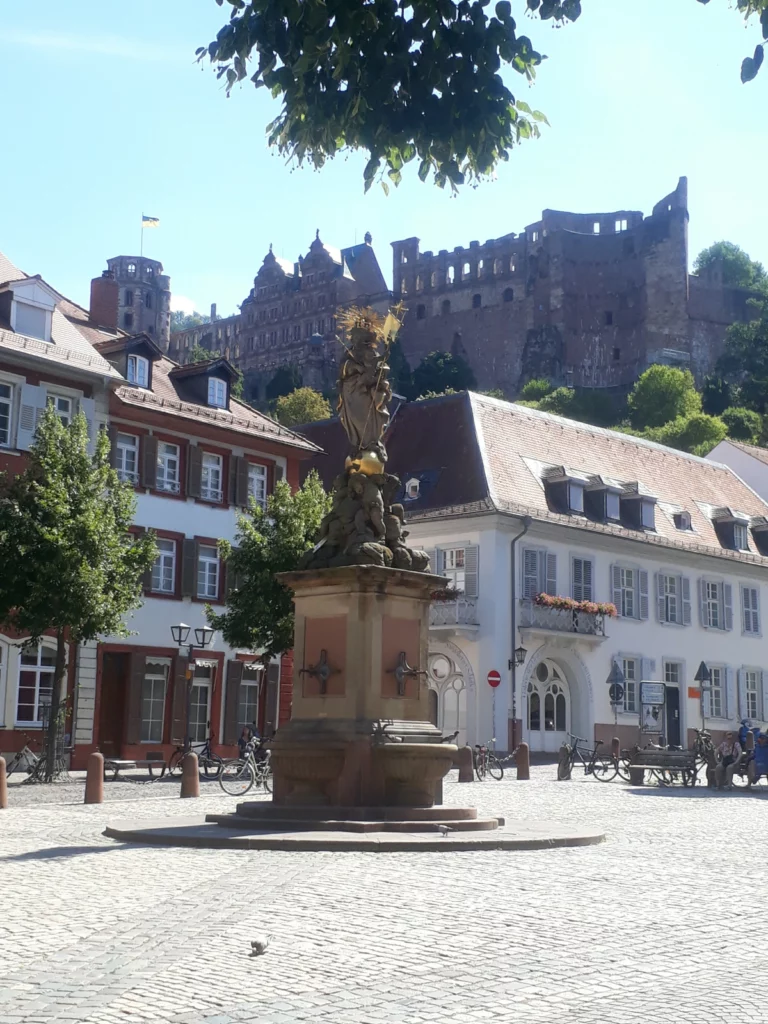
The lower station of the funicular is located on the square. And two path to the castle start from it – a steep one without steps and a long staircase.
Old bridge (Alte Brücke, Karl Theodor Bridge)
The bridge was built in 1786. This is the fifth bridge over the Neckar at this place, but the first made of stone. Two gate towers on the bridge were part of the city walls, they housed a prison.


The statue of a monkey on the bridge (1979) allegorically conveys the urban legend that any resident, crossing the bridge, must look back and remember that a resident in the city is no better than a resident outside it, and vice versa.
Such a monkey already existed in the 15th century, as evidenced by the drawings. She disappeared during the war with the French.
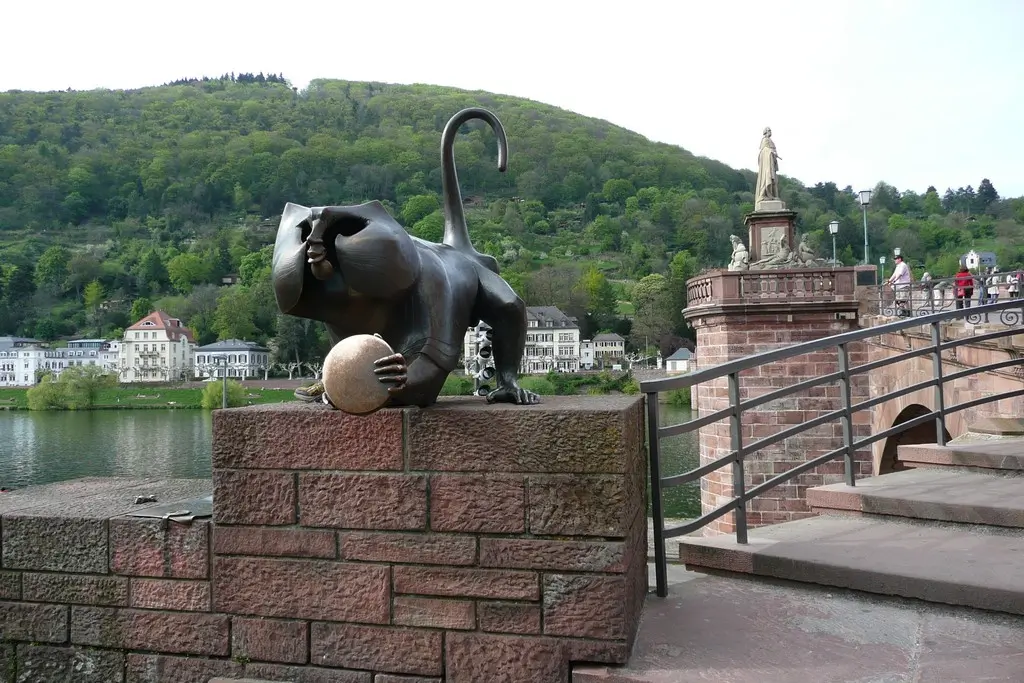
Heiligenberg and the Philosophers’ Trail
When you travel by train from Mannheim across the flat terrain, you don’t expect such imposing hills to suddenly appear from somewhere. If you take the train even further along the Neckar, towards Heilbronn and Stuttgart, the area becomes even more picturesque.
There are two hills in Heidelberg – the “Royal Throne” (Königstuhl, on the right) and the “Mountain of the Holy Spirit” (Heiligenberg, on the left).

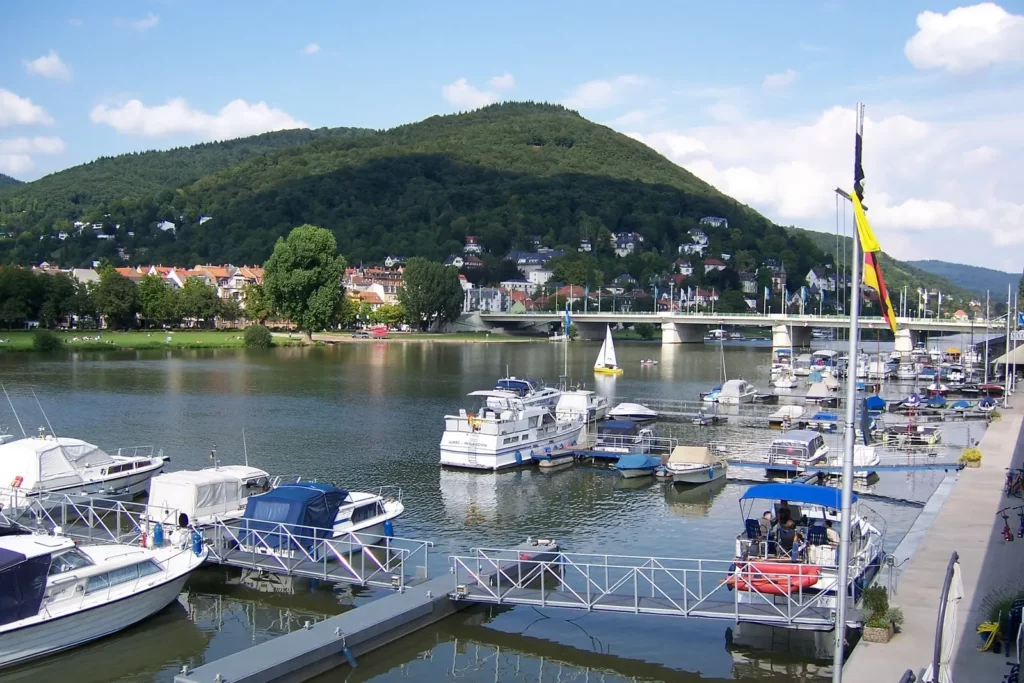
The first Celtic settlement appeared on Heiligenberg in the 5th century BC. Then on its ruins – the monastery of St. Michael (870). Monastery of St. Michael was abandoned after the three remaining monks died in their beds in 1503 due to the collapse of part of the spire. Now you can see the ruins of the monastery.
In addition, there is a large amphitheater Thingstätte upstairs, built during the Nazi period for propaganda events.
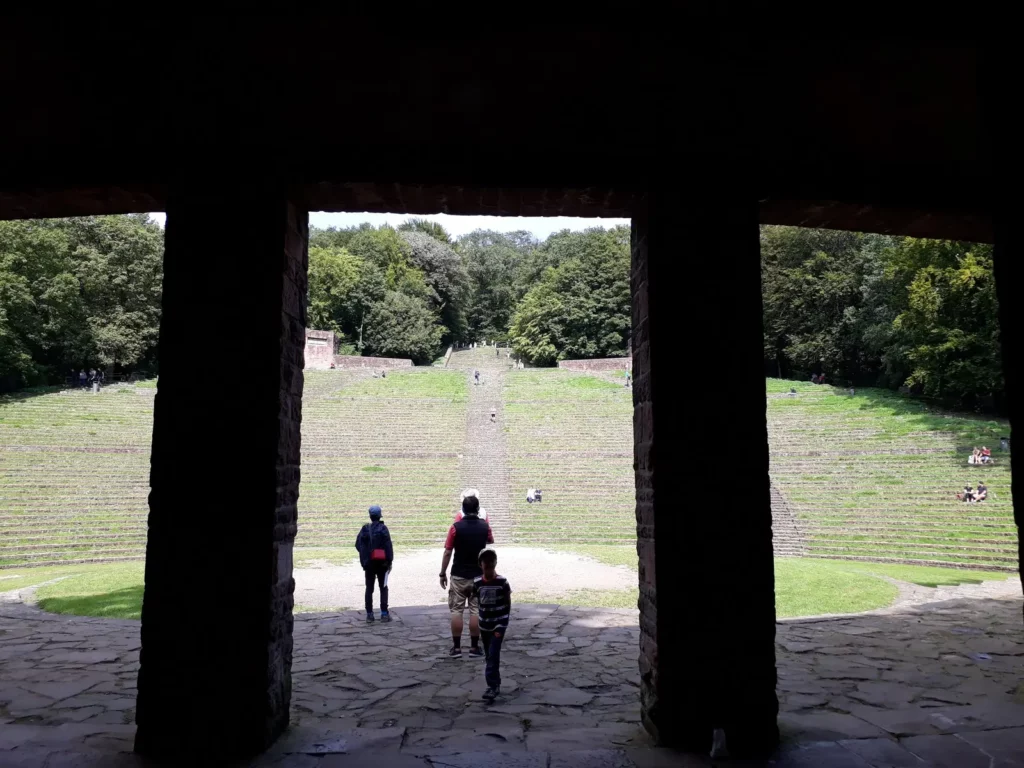
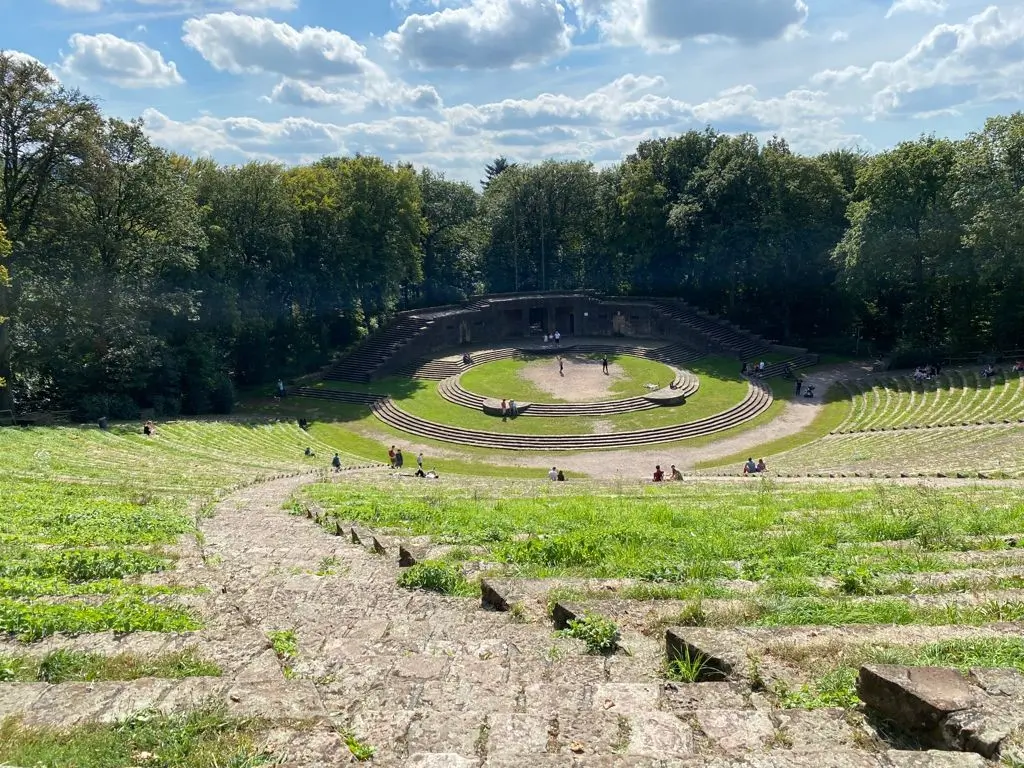
Follow me
The ruins at the top are in a completely ruined state. There are no views from the top.
In the middle of the hill is the Philosophers’ Trail (Philosophenweg). It was named so during the era of romanticism, because university professors and philosophers liked to walk here for solitary reflection and relaxation, and before that it was just a path between vineyards. On the hill – a milder, almost Mediterranean, climate than in the valley. Therefore, trees that are not typical for this area grow here – lemons, pomegranates, cypresses and palm trees, edible chestnuts.
The trail offers a magnificent view of the city and the castle. You can get on the trail from Theodor Heuss bridge, from the Old Bridge – along the Snake path (Schlangenweg, the shortest road) or along Hirschgasse street from the dam.

What to visit
Heidelberg is a cozy city that is nice to just walk around. Go to the castle, climb the Philosophers’ trail, go for impressions in the surroundings. However, there is also something to visit on very rainy days.
Heidelberg has some very original museums (like the Packing Museum and the Bonsai Museum) and third-rate specialist museums.
There is certainly a museum of the region that is found in every more or less large city. In this case, it is called the Museum of the Palatinate (Kurpfälzisches museum), or the Palatine Museum.
The museum of the university and the student punishment cell may be of some interest.
The Old University (Alte Universität) was built in 1718. Now it is occupied by the Old Assembly (Alte Aula) and the University Museum. Next to the building is a student punishment cell (Studentenkarzer).
Punishment cell was used from 1778 to 1914. The imprisonment in it was not as severe as in a real prison: students ended up here for disturbing the peace – they left it for the duration of the lectures, and then returned again. The walls of the punishment cell are covered with inscriptions, images and cartoons. Check, how to visit Studentenkarzer – it can be pre-booking.
There is also a museum of ancient art in the university.
Heidelberg also has a zoo and a botanical garden. Both are not in the city center, behind the university clinic on the other side of the river. It is better to go there by public transport. The zoo is small, but very good, an example of how you can successfully show animals in a small area. The botanical garden is very small. It has a greenhouse, but the area around it looks abandoned.
Around Heidelberg
The city lies on the edge of the Odenwald Nature Park. The Neckar valley cycling route and the Neckarsteig hiking route are popular. If you are not interested in cycling, you should take a steamboat or train to Neckarsteinach and see the castles and Dilsberg Fortress.
Read more about first part of Neckar Trail.
Of the possible excursions, it is also worth mentioning Speyer (technic museum and the famous cathedral, 45 minutes by train) and a large picturesque park with a small palace and a wonderful cherry garden in Schwetzingen (25 minutes from the station by bus 717 or tram 20).
Read more:
Speyer town, technic museum
Schwetzingen park and cherry garden
Another tourist destination is the second (chronologically first) site of the Technic Museum – in Sinsheim (approx. 30 minutes by train), which can be combined with Bad Wimpfen ( the same train for another 15 minutes).
Read more:
Sinsheim Technic Musem
Bad Wimpfen and second part of Neckar Trail
If you drive one more stop to Bad Friedrichshall, then you can return to Heidelberg by a beautiful train route going through Eberbach (indicate Eberbach as an intermediate point in the timetable, otherwise you will get a shorter route through Sinsheim).
Technic Museums are different, each has its own “masterpieces”, like Buran or supersonic aircraft, so it is recommended to see in advance what is exhibited in each of the museums and choose what is interesting for you.
The half-timbered town and the small garden famous for its wisteria are accessible by tram 5 – Weinheim.
Read more about Weinheim
Do you enjoy the site without cookies? This means that I work for you at my own expense.
Perhaps you would like to support my work here.
Or change your cookie settings here. I don’t use personalized ads

